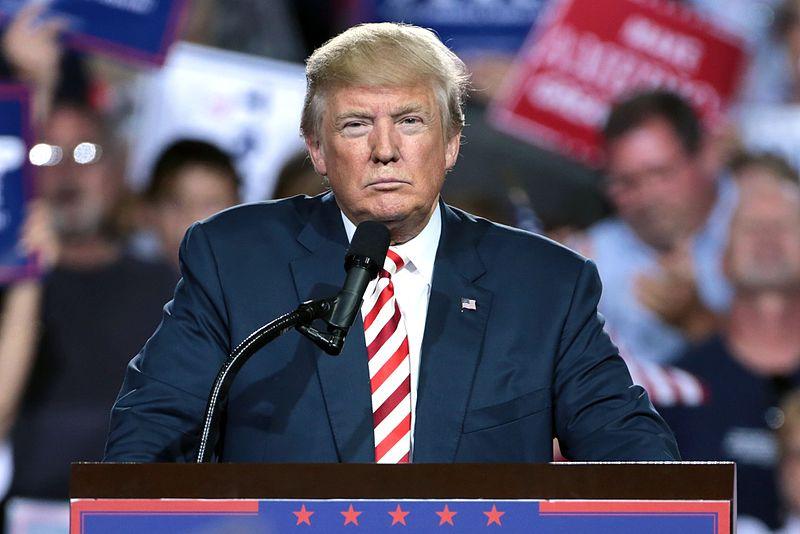Trump Paid $750 in Federal Tax, $1 Million in Foreign Taxes in 2017

Donald Trump speaking with supporters at a campaign rally at the Prescott Valley Event Center in Prescott Valley, Arizona. Representational Image. Image Courtesy: Wikimedia Commons
The release of six years of former United States (US) President Donald Trump’s personal and business tax returns on Friday revealed that he paid negligible federal income taxes in the first and last year of his presidency by claiming huge losses; made several claims that could be questioned by auditors, held several foreign bank accounts, including in China between 2015 and 2020; and made no charitable contributions in 2020 contrary to his 2015 election campaign promise.
The returns, which were made public following the end of a battle over their disclosure which went to the Supreme Court, confirmed a report issued by the Joint Committee on Taxation (JCT) that the 45th President claimed large losses before and throughout his presidency—$105 million in 2015 and $73 million in 2016—to reduce or practically eliminate his tax burden, CNN reported.
TRUMP CLAIMED HUGE LOSSES
The thousands of pages of documents, made public by Democrats on the House Ways and Means Committee, showed that Trump and his wife Melania received tens of millions of dollars in investment income each year but also claimed deductions and losses in their businesses in millions, sharply reducing their income tax liability.
A quick look at Trump's tax returns shows it's clear his returns deserved extensive audits. He made millions but escaped taxes by declaring tremendous losses. These losses must be confirmed—not taken at face value. The IRS not auditing him is highly suspicious. #TrumpTaxes
— David Corn (@DavidCornDC) December 30, 2022
The former First couple reported adjusted gross income of $24.3 million in 2018 and paid a net tax of $1 million. In 2019, they reported $4.4 million of income and paid $134,000 in taxes—the only two years when they claimed positive gross income.
In 2017, the Trumps reported a gross income of negative $12.9 million, which reduced their income tax bill to only $750. In 2020, they paid no income tax by reporting a negative gross income of $4.8 million.
"On their 2020 income tax returns, Trump and his wife Melania paid no federal income taxes and claimed a refund of $5.47 million, according to the report by the staff of the Joint Committee on Taxation." https://t.co/rOTgbTdmFL
— John Harwood (@JohnJHarwood) December 21, 2022
QUESTIONABLE CLAIMS
After reviewing the returns, the JCT flagged several of Trump’s claims that were questionable, including “eyebrow-raising amounts of interest” he received from loans given to his children.
The bipartisan committee said that such claims could indicate that Trump was disguising them as gifts. For example, the JCT argued if the interest Trump claims to have charged his children was not at market rate, it could be considered a gift for tax purposes, which would require him to pay a higher tax rate.
Trump claimed to have received exactly $18,000 in interest on a loan given to his daughter Ivanka and $8,715 in interest from his son Donald Trump, Jr.. From 2017 to 2019, Trump said that he received exactly $24,000 from his son Eric, who paid him $19,605 in interest in 2020.
“Were the loans bona fide arm’s length transactions or whether the transfers were disguised gifts that could trigger gift tax and a disallowance of interest deductions by the related borrowers,” the JCT said in its report, according to CNN.
“It’s unusual to have interest in round numbers—very rare. An auditor would want to see payments, loan agreements and interest rates,” Martin Sheil, former supervisory special agent for the Internal Revenue Service’s (IRS) Criminal Investigation unit told CNN.
Trump also listed an identical amount of company expenses and income from his business DJT Aerospace LLC in 2017. The company, which operates Trump’s personal helicopter, claimed $42,965 as both income and expenses, showing zero income.
"Here is the most powerful man in the world...and he did not pay the taxes that the most modest wage earner in this country would pay...Americans should be outraged by that": Rep. Lloyd Doggett on Trump's tax returns. pic.twitter.com/dWLS2FMpxo
— MSNBC (@MSNBC) December 30, 2022
“Total expenses equalling total income is a statistical impossibility. It just doesn’t happen,” Sheil added.
FOREIGN BANK ACCOUNTS
As per law, Trump was required to report his foreign bank accounts between 2015 and 2020, including one in China between 2015 and 2017, to the Financial Crimes Enforcement Network.
According to the documents, he maintained bank accounts in China, the United Kingdom (UK) and Ireland.
The China bank account, reported by The New York Times (NYT) in 2020, was tied to Trump International Hotels Management’s business push in the country, according to Trump Organization lawyer Alan Garten at the time.
The papers also revealed that Trump paid around $1 million in taxes to foreign countries in 2017 but only $750 in federal income taxes, showing his companies and businesses interests are spread in Azerbaijan, Panama, Canada, India, Qatar, South Korea, UK, China, the Dominican Republic, United Arab Emirates, the Philippines, Grenada, US territory Puerto Rico, Georgia, Israel, Brazil, St. Maarten, Mexico, Indonesia, Ireland, Turkey and St. Vincent.
According to a 2019 report by the watchdog group OpenSecrets, Trump had more than $130 million in assets in more than 30 countries, the POLITICO reported. The tax returns showed that he received extensive income from Canada, Ireland and UK—including gross business income of, at least, $35.3 million from Canada in 2017. In the same year, he also brought in $6.5 million from China, $5.8 million from Indonesia and $5.7 million from India.
By 2020, Trump reported $8.8 million in income from the UK and another $3.9 million in Ireland.
NO CHARITABLE CONTRIBUTION IN 2020
Contrary to his 2015 campaign promise of not taking “even one dollar” of the $400,000 presidential salary, Trump didn’t give even $1 in charity in 2020, NYT reported citing the documents.
Trump reported charitable donations amounting to around $1.9 million in 2017 and just over $500,000 in both 2018 and 2019, but in 2020, as the pandemic recession swiftly descended, he reported heavy business losses and no federal tax liability.
NO FULL REFUND DESPITE ‘LOSSES’
Despite reporting around $16 million in business losses in 2020, according to the documents, Trump made nearly $14 million in tax payment to the federal government over the course of the year, NYT reported.
Strangely, he didn’t claim the full refund immediately. After claiming a refund of around $5.5 million, he directed the IRS to apply for a refund of another $8 million.
TRUMP’S OWN TAX LAW MIGHT HAVE COST HIM
The 2017 tax law, Trump signed in late 2017, capped the state and local tax (SALT) deduction at $10,000 a year and hit higher earners, including him, in high-tax cities and states like New York but drastically reduced the income tax deductions he could claim in 2018.
In 2019, Trump reported paying $8.4 million in state and local taxes as he was able to deduct only $10,000 of those taxes paid on his federal income tax return. In 2020, Trump said that he paid $8.5 million in SALT but claimed the maximum allowable $10,000.
In contrast, Trump was able to deduct significantly more from state and local taxes in 2016 and 2017—he deducted $5.2 million each year in SALT payments in both years.
Get the latest reports & analysis with people's perspective on Protests, movements & deep analytical videos, discussions of the current affairs in your Telegram app. Subscribe to NewsClick's Telegram channel & get Real-Time updates on stories, as they get published on our website.
























